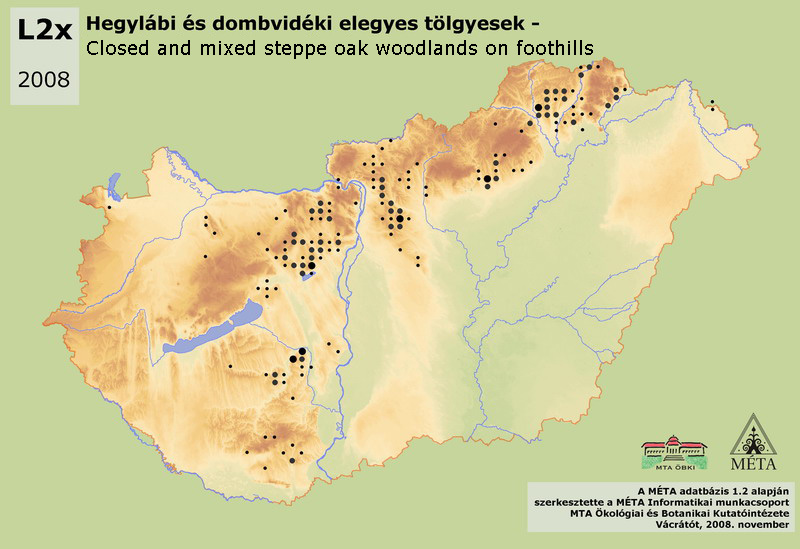MÉTA Program >>> Élőhelyek elterjedési térképei


L2x - Hegylábi és dombvidéki elegyes tölgyesek:
Szárazabb éghajlati körülmények között, többnyire löszön vagy hasonló jellegű laza üledéken, a tölgyes zóna hegylábi részein, ill. az Alföld szélén kialakuló elegyes tölgyesek, amelyek tulajdonságaikban nem ritkán a cseres-tölgyesek [L2a], a nyílt lösztölgyesek [M2], a gyertyános-tölgyesek [K1a] és olykor a mész- és melegkedvelő tölgyesek [L1] között állnak. Legjellemzőbb fafajuk valamelyik tölgyfaj (cser-, molyhos, kocsányos, ritkán a kocsánytalan tölgy – Quercus cerris, Q. pubescens, Q. robur, Q. petraea), de a magas, a magyar és a virágos kőris (Fraxinus excelsior, F. angustifolia ssp. pannonica, F. ornus), a mezei és tatár juhar (Acer campestre, A. tataricum), a kis- és nagylevelű hárs (Tilia cordata, T. platyphyllos) közül is legalább két faj jelen van. Többnyire fejlett magas cserjeszinttel rendelkező vagy fiatal fákkal betöltődött erdők. A gyepszintben az üde, a száraz és fényben gazdag erdők fajai, sőt száraz gyepi fajok is előfordulhatnak. A zárt lösztölgyesek jelenlegi kiterjedése nem éri el a 4500 ha-t. Elsősorban a középhegységek és az Alföld találkozási sávjában maradtak meg állományai. Egyes területeken sűrűbben fordul elő, máshol teljesen hiányzik, az előfordulások így koncentrálódnak. Ilyen centrumok a Cserehát a Sátor-hegység lábával együtt, a Bükk déli peremvidéke, a Cserhát déli része és a Gödöllői-dombvidék, a Mezőföld északi része a Velencei-hegységgel és a Véres, a Gerecse és a Budai-hegység kapcsolódó hegylábi területeivel, a Mezőföld északnyugati széle a Keleti-Bakony és a Balaton-felvidék peremével, a Tolnai-hegyhát és környéke, valamint a Baranyai-dombság. Az állományok a sűrűbb előfordulási területeken belül is többnyire kis szigeteket képeznek, nagyobb erdőtömböket ma már alig alkotnak (kivétel: Kerecsendi-erdő, Velencei-hegység, Tolnai-hegyhát). Az Alföldbe „legmélyebben” a Mezőföldön és a Monor-Irsai-dombság peremén hatol. A hegylábi állományok a zárt molyhos tölgyesektől [L1] gyakran alig választhatók el.
L2x – Closed and mixed steppe oak woodlands on foothills:
Developed in dry climate and mainly on loess or on other similar sediments, these forests usually grow on the foothills of the oak woodland zone, or at the edge of Alföld. This is a mixed oak forest of Quercus pubescens, Q. robur, Q. cerris and/or Q. petraea, but usually at least two other species are present, such as: Fraxinus excelsior, F. angustifolia subsp. pannonica and/or F. ornus, Acer campestre, A. tataricum, Tilia cordata, T. platyphyllos. The shrub layer is high and dense, often with a second layer of infilled young trees. Species of mesic, dry and/or light forests compose the herb layer, moreover, species of dry grasslands can also occur. According to its attributes, this habitat type is situated between the loess steppe oak woodlands (M2), the turkey oak woodlands (L2a), the oak-hornbeam woodlands (K1a) and/or the closed termophilous oak woodlands (L1). The total area of the habitat is less than 4500 ha. Its stands remained mainly in the border zone of Alföld and the foothills of the mountains. It is completely absent from certain regions, while aggregating in other places; resulting in the concentration of occurrences. These centres are Cserehát with the foothills of the Sátor-hegység, the southern edge of Bükk, the southern part of Cserhát with the Gödöllői-dombvidék, the northern part of Mezőföld with the Velencei-hegység and Vértes, Gerecse with the connecting foothills of the Budai-hegység, the western/south-western part of Mezőföld with the edges of Keleti-Bakony and Balaton-felvidék, Tolnai-hegyhát and its vicinity, and the Baranyai-dombság. The stands mostly form small islands also within these regions; they do not cover larger blocks nowadays (some exceptions are: Velencei-hegység, Tolnai-hegyhát, Kerecsendi-erdő on the foothills of Bükk). It penetrates most pregnantly into Alföld on Mezőföld and at the edges of the Gödöllői-dombvidék. The foothill stands and that of the closed termophilous oak woodlands’ (L1) are hardly distinguishable.
Molnár, Zs., M. Biró, J. Bölöni & F. Horváth (2008): Distribution of the (semi-)natural habitats in Hungary I.: Marshes and grasslands, Acta Botanica Hungarica 50 (Suppl): 59-105. >>> letöltés (5,4 MB, PDF)
MÉTA Program,
MÉTA Fotótár
MÉTA Élőhely-Ismereti Útmutató (ÉIÚ),
MÉTA Adatlap-Kitöltési Útmutató (AL-KÚ)
(C) MÉTA Informatika, 2005-2009,
MTA Ökológiai és Botanikai Kutatóintézete